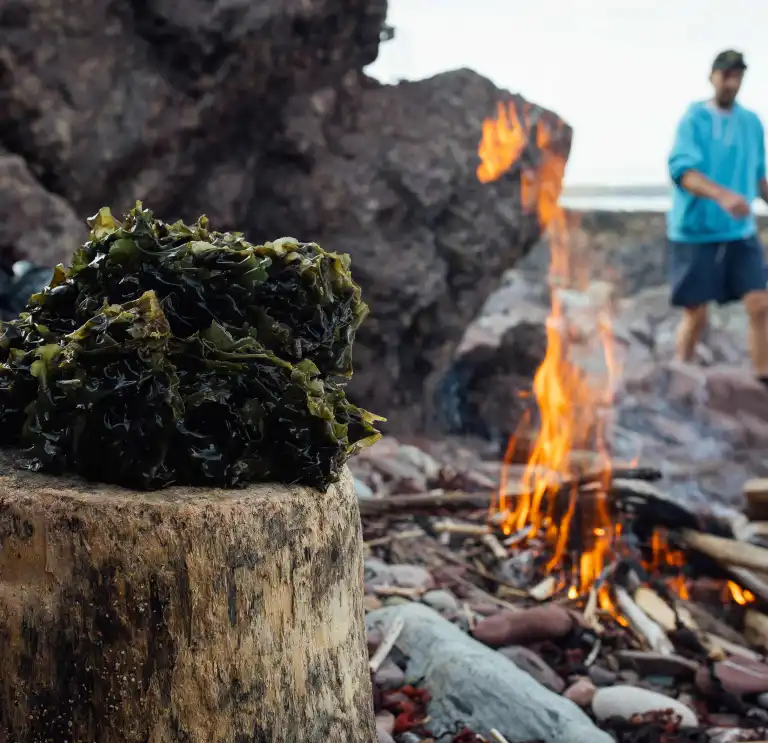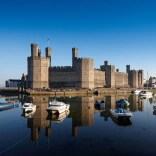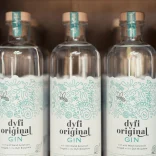Nothing quite induces hunger pangs like witnessing a Welsh kitchen in full swing: a joint of lamb roasting in the oven, chopped leek sauteing in a frying pan, and, of course, a big vat of algae boiling on the stove.
Though it might not receive the acclaim of some of our other famed foodstuffs, seaweed has long been a delicacy in Wales, and has enjoyed something of a renaissance in the last few years, spurred by celebrity endorsements and the creation of its own national day.
Looking to try some Welsh ‘laverbread’ for yourself? Here’s everything you need to know about Wales’ superfood from the Irish Sea.


Do people in Wales really eat seaweed?
A plate of boiled seaweed may not appear the most appetising prospect at first. But the its popularity tells you how delicious it really is.
A number of different types of seaweed are eaten in Wales, but by far the most common is laver, a type of flat, dark red sea algae that’s found along the shoreline of the country’s western coast.

After being plucked from rocky beaches, the laver is slowly boiled into a salty black paste, which is rich in iodine, giving it a flavour some compare to olives and oysters. From here, it’s typically mixed with oats, and fried into the preferred consistency. It can be eaten on its own, but – believe it or not – is most commonly enjoyed at breakfast time, where it’s paired with bacon and eggs as part of a traditional Welsh fry up.
In its cooked form, the ingredient itself is known as ‘laverbread’, a slightly misleading name thought to stem from the fact the collected laver was traditionally kneaded and rolled into balls, like bread, before being cooked. Laverbread is one of our foods with protected status. This protection ensures consumers know the seaweed they’re buying is sourced from the Welsh coast and adheres to a particular quality, as well as singling laverbread out as one of the distinctive tastes of Wales.


A true taste of Wales
Laverbread has been eaten in Wales since at least the 18th century, when cash-strapped locals began foraging for it along the beaches of coastal areas, including the Gower peninsula and Ynys Mon (Anglesey). It was later sold commercially in Welsh towns, notably in Swansea Market, where it was hauled by donkey cart from the beaches of Pembrokeshire. Its nutritional value, packed with iron, protein, iodine and vitamin C, was so well known that there are records of laverbread being prescribed by doctors to worn-out coal miners (and what could be more Welsh than that?).

The dish truly entwined itself into Welsh identity, however, when it became associated with one of Wales’ greatest ever characters, the actor Richard Burton, who reputedly proclaimed laverbread to be ‘Welshman’s caviar’, a title that has stuck ever since. (Although whether the actor actually ever said this is, in reality, uncertain, and perhaps the title is better attributed to the pioneering writer on Welsh cuisine, Bobby Freeman, who dubbed laverbread: Caviare Cymreig.)
In the years since, Welsh seaweed has enjoyed further high-profile endorsements thanks to its unique taste and impressive health-benefiting properties, including an impassioned recent review from maître d'-turned-TV personality Fred Sirieix.
Are there other types of edible seaweed in Wales?
Though laver is by far the most common sea algae eaten in Wales, other edible seaweed sold in the country includes sugar kelp (laminaria saccharina) and dulse (palmaria palmata). Both of these make for great additions to soups, broths, and – apparently – mashed potato, and are available to purchase from Câr-Y-Môr, Wales’ first regenerative seaweed and shellfish farm, based in St Davids, Pembrokeshire.
Other forms of seaweed are sold at specialist shops around the country, including at Halen Môn, on the isle of Anglesey. Here, visitors can not only pick up a variety of dried Welsh seaweeds, but also undertake a one-of-a-kind seaweed spa experience – serenely stewing in mineral-dense, algae-filled waters in an upcycled wooden whisky barrel.

In fact, alongside being good to eat and containing oils that are deemed beneficial for the skin, seaweed has many other uses. It’s a natural carbon sink, making it a vital resource in the battle against climate change, and also helps to keep our seas clean by removing contaminants from seawater. Seaweed has even been touted as a future replacement for ocean-damaging plastic. Talk about a superfood!
Isn’t Japan also famous for eating seaweed?
Japan is another country with a serious appetite for algae – another of many links between Wales and Japan. However, the connection goes deeper than a simple affection for the green stuff.
Despite having never set foot in Japan, British biologist Kathleen Drew-Baker is revered in the Asian country, where she has been bestowed the title of “Mother of the Sea”, and even has her own shrine in the city of Uto in Kumamoto Prefecture.
This endearment is due to the biologist’s trailblazing research into the life cycle of algae, which was later utilised by Japanese farmers to significantly boost seaweed production rates and reverse a long-term decline in the Japanese nori industry (a type of seaweed used frequently in Japanese cuisine). It was on the beaches of North Wales that Kathleen originally conducted this industry-revolutionising research.
Alright, I’m convinced, where can I try some Welsh laverbread?
The best place to try it is, obviously, in Wales. As mentioned, seafood stalls across South and West Wales have been selling laverbread for generations, and two of the country’s biggest and most beloved indoor markets, Cardiff Market and Swansea Market, remain sure-fire bets to get your hands on some laverbread fresh from the Welsh coastline.


In fact, the only way to find a fresher batch of laver is to pluck it from the rockface yourself, an activity that’s offered by the Really Wild Emporium, in St Davids. The enterprise runs popular seaweed foraging courses on the local beaches, with the day’s finds typically whipped up into delicious, algae-enriched dishes.
However, for those wanting to forgo any cooking of their own (or go rummaging around in any rock pools!), there are many restaurants and pubs scattered throughout the country that proudly plate up the delicacy in a ready-to-eat format. These include The Bull Terrier Cafe, in Cardiff (actually located in Cardiff Market itself), Cariad Cafe in Pen-clawdd (on the Gower Peninsula) and Coast Deli in Aberdyfi (located within Eryri (Snowdonia) National Park).
West Wales chef Jonathan Williams, who owns the solar-powered seafood truck Cafe Mor, is such a fan of laverbread he even created National Laverbread Day for the delicacy. Observed annually on 14 April, the seaweed-themed celebrations (featuring cooking and photography competitions!) are centred on the The Old Point House pub, in Pembrokeshire, but expect an outpouring of algae-affection from an increasing number of venues across West Wales to mark one of the country’s quirkiest additions to the calendar. (Though Welsh Rarebit Day, in September, may have something to say about that!)
Unable to make it to Wales? Welsh company Parsons Pickles has been producing its canned laverbread since the 1980s, which is available for export internationally from its website. The perfect Welsh souvenir? Weed certainly say so.



